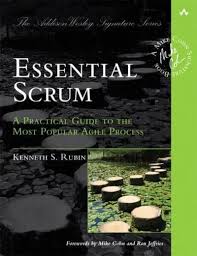
Essential Scrum: A Practical Guide to the Most Popular Agile Process, 1st edition
PUBLISHER: PEARSON
eBook edition. 1 Year Subscription. Dành cho Cá nhân | Trường ĐH, Nhóm, Thư Viện: Gọi 0915920514 để báo giá Pearson, Vital Source eBook hoặc mua Sách In
Nếu bạn muốn sử dụng Scrum để phát triển các sản phẩm và dịch vụ đổi mới làm hài lòng khách hàng của mình, thì Essential Scrum là nguồn tài liệu tham khảo hoàn chỉnh, duy nhất mà bạn đang tìm kiếm. Huấn luyện viên và huấn luyện viên hàng đầu về Scrum Kenny Rubin làm sáng tỏ các giá trị, nguyên tắc và thực tiễn của Scrum, đồng thời mô tả các phương pháp tiếp cận linh hoạt, đã được chứng minh có thể giúp bạn triển khai Scrum hiệu quả hơn nhiều. Cho dù bạn là người mới làm quen với Scrum hay đã sử dụng nhiều năm, cuốn sách này sẽ giới thiệu, làm rõ và đào sâu kiến thức về Scrum của bạn ở cấp độ nhóm, sản phẩm và danh mục đầu tư. Rút kinh nghiệm từ kinh nghiệm của Rubin khi giúp hàng trăm tổ chức thành công với Scrum, cuốn sách này cung cấp những mô tả dễ hiểu được tăng cường bởi hơn hai trăm hình minh họa dựa trên ngôn ngữ biểu tượng trực quan hoàn toàn mới để mô tả vai trò, tạo tác và hoạt động của Scrum. Essential Scrum sẽ cung cấp cho mọi thành viên trong nhóm, người quản lý và người điều hành những hiểu biết chung về Scrum, một vốn từ vựng chung mà họ có thể sử dụng khi áp dụng nó và kiến thức thực tế để thu được giá trị tối đa từ nó.
- List of Figures xxvForeword by Mike Cohn xxxiForeword by Ron Jeffries xxxiiiPreface xxxvAcknowledgments xxxixAbout the Author xliii
- Chapter 1: Introduction 1What Is Scrum? 1Scrum Origins 3Why Scrum? 4Genomica Results 4Can Scrum Help You? 5Closing 10 Part I: Core Concepts 11
- Chapter 2: Scrum Framework 13Overview 13Scrum Roles 14Scrum Activities and Artifacts 16Closing 28
- Chapter 3: Agile Principles 29Overview 29Variability and Uncertainty 32Prediction and Adaptation 37Just-in-Time Work 43Validated Learning 44Work in Process (WIP) 48Progress 54Performance 56Closing 58
- Chapter 4: Sprints 61Overview 61Timeboxed 62Short Duration 64Consistent Duration 67No Goal-Altering Changes 69Definition of Done 74Closing 78
- Chapter 5: Requirements and User Stories 79Overview 79Using Conversations 81Progressive Refinement 82What Are User Stories? 83Level of Detail 86INVEST in Good Stories 88Nonfunctional Requirements 93Knowledge-Acquisition Stories 93Gathering Stories 95Closing 98
- Chapter 6: Product Backlog 99Overview 99Product Backlog Items 100Good Product Backlog Characteristics 101Grooming 104Definition of Ready 108Flow Management 110Which and How Many Product Backlogs? 112Closing 118
- Chapter 7: Estimation and Velocity 119Overview 119What and When We Estimate 120PBI Estimation Concepts 123PBI Estimation Units 128Planning Poker 129What Is Velocity? 133Calculate a Velocity Range 134Forecasting Velocity 135Affecting Velocity 135Misusing Velocity 137Closing 138
- Chapter 8: Technical Debt 139Overview 139Consequences of Technical Debt 141Causes of Technical Debt 144Technical Debt Must Be Managed 148Managing the Accrual of Technical Debt 149Making Technical Debt Visible 153Servicing the Technical Debt 155Closing 162 Part II: Roles 163
- Chapter 9: Product Owner 165Overview 165Principal Responsibilities 166Characteristics/Skills 171A Day in the Life 174Who Should Be a Product Owner? 176Product Owner Combined with Other Roles 181Product Owner Team 182Closing 184
- Chapter 10: ScrumMaster 185Overview 185Principal Responsibilities 185Characteristics/Skills 188A Day in the Life 190Fulfilling the Role 191Closing 193
- Chapter 11: Development Team 195Overview 195Role-Specific Teams 195Principal Responsibilities 196Characteristics/Skills 198Closing 211
- Chapter 12: Scrum Team Structures 213Overview 213Feature Teams versus Component Teams 213Multiple-Team Coordination 218Closing 223
- Chapter 13: Managers 225Overview 225Fashioning Teams 227Nurturing Teams 231Aligning and Adapting the Environment 233Managing Value-Creation Flow 235Project Managers 237Closing 243 Part III: Planning 245
- Chapter 14: Scrum Planning Principles 247Overview 247Don’t Assume We Can Get the Plans Right Up Front 248Up-Front Planning Should Be Helpful without Being Excessive 248Keep Planning Options Open Until the Last Responsible Moment 249Focus More on Adapting and Replanning Than on Conforming to a Plan 249Correctly Manage the Planning Inventory 251Favor Smaller and More Frequent Releases 252Plan to Learn Fast and Pivot When Necessary 254Closing 255
- Chapter 15: Multilevel Planning 257Overview 257Portfolio Planning 259Product Planning (Envisioning) 259Release Planning 261Sprint Planning 264Daily Planning 264Closing 265
- Chapter 16: Portfolio Planning 267Overview 267Scheduling Strategies 270Inflow Strategies 275Outflow Strategies 280In-Process Strategies 283Closing 285
- Chapter 17: Envisioning (Product Planning) 287Overview 287SR4U Example 290Visioning 291High-Level Product Backlog Creation 294Product Roadmap Definition 295Other Activities 298Economically Sensible Envisioning 299Closing 306
- Chapter 18: Release Planning (Longer-Term Planning) 307Overview 307Release Constraints 311Grooming the Product Backlog 315Refine Minimum Releasable Features (MRFs) 316Sprint Mapping (PBI Slotting) 316Fixed-Date Release Planning 318Fixed-Scope Release Planning 323Calculating Cost 325Communicating 326Closing 330 Part IV: Sprinting 333
- Chapter 19: Sprint Planning 335Overview 335Approaches to Sprint Planning 338Determining Capacity 340Selecting Product Backlog Items 343Acquiring Confidence 344Refine the Sprint Goal 346Finalize the Commitment 346Closing 346
- Chapter 20: Sprint Execution 347Overview 347Sprint Execution Planning 349Flow Management 349Daily Scrum 354Task Performance—Technical Practices 355Communicating 356Closing 360
- Chapter 21: Sprint Review 363Overview 363Participants 364Prework 365Approach 368Sprint Review Issues 372Closing 373
- Chapter 22: Sprint Retrospective 375Overview 375Participants 377Prework 378Approach 380Follow Through 391Sprint Retrospective Issues 392Closing 393
- Chapter 23: The Path Forward 395There Is No End State 395Discover Your Own Path 396Sharing Best Practices 396Using Scrum to Discover the Path Forward 397Get Going! 398 Glossary 401References 423Index 427















